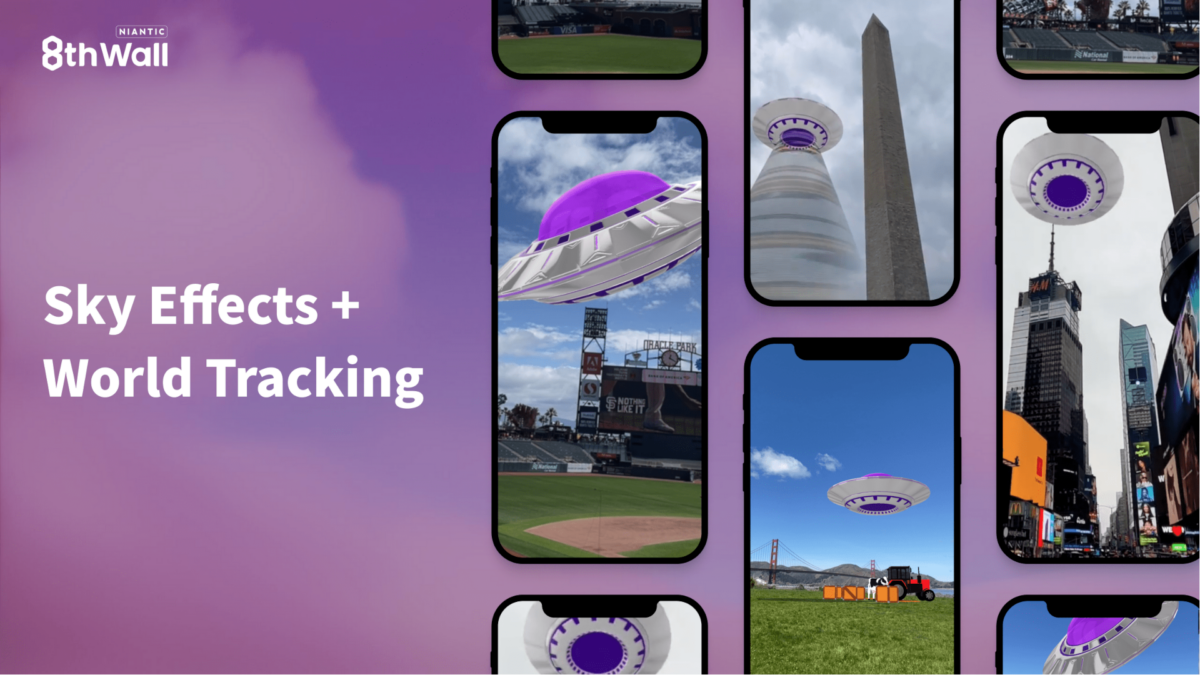Niantic's browser AR software makes UFOs appear in the sky

April 6, 2023:
Following UFO sightings from the Pentagon, AR worlds are also experiencing aerial invasions: 8th Wall has announced that Niantic's browser AR software now also supports effects in the sky. Thus, content like flying saucers or fireworks precicely appears over real locations, made possible by the "AR cloud".
The seamless interaction of "sky effects" and "world tracking" enables experiences with complete environmental changes of the sky and the ground, the studio explains. Creators can refine the hard boundaries between layers with new edge adjustment tools to match the scenery.
Original article from September 25, 2022:
The "Visual Positioning System" from Niantic brings AR users into the same digital space. The software now runs directly in the browser.
AR games like the smash hit Pokémon Go initially relied mostly on inaccurate GPS data and did not accurately locate players on the virtual map. Niantic's "Visual Positioning System" (VPS) is supposed to remedy this: The system, which was rolled out to AR studios at the end of May, places players precisely and permanently on a shared 3D map.
Thanks to this so-called AR cloud, players can see the same digital objects in the same place with centimeter precision, according to Niantic. In the monster-hunting example, several people could gather around a digital creature in the park to eye it from all sides at once. Retailers could lure customers into stores where they can go in search of precisely placed AR installations or puzzles.
Niantics Lightship VPS for mobile browsers
VPS for Niantic's own AR SDK Lightship is available for dedicated apps. Now, the company is additionally announcing "Lightship VPS for Web," which makes content associated with real-world locations available in the mobile browser.
⛅ Augment everything with Sky Effects and World Tracking 🌍
Now, developers, agencies, and brands can use Sky Effects + World Tracking to create never-before-seen immersive WebAR experiences that use the entire field of view as a canvas for AR. https://t.co/8nmbPUWj2M pic.twitter.com/brCMfufd8W
— 8th Wall (@the8thwall) March 28, 2023
Interested developers can thus create unlimited experiences in numerous places and landmarks, for example, linked scavenger hunts.
Fittingly, Niantic has already dubbed the concept a "Worldscale" solution that synchronizes numerous AR-enabled systems across iOS and Android. Smartphones with built-in LiDAR depth sensors are supported, as are camera-only smartphones.
The (AR) world comes to life
A trailer shows the browser software in action: the Luxor Obelisk in Paris becomes a strange, glowing monolith with floating rings for all participants, which could be used to create a puzzle in the style of the adventure game Myst.
In Sydney, a statue transforms into a creepy Ghostbusters-style creature, with crows fluttering menacingly. In an LA garden, visitors throw coconuts at identical digital targets.
To make all this possible, Niantic combines its VPS with a solution from developer studio 8th Wall, which it acquired in March. It has already made it easier to create and publish professional and platform-independent AR content in 2019.
Many traditional augmented reality experiences from big brands already made use of 8th Wall's platform, including Pepsi, Microsoft, Netflix, or Universal Pictures.
A strength of Niantic's VPS mapping of the real world is that a large community of developers, gamers, and mappers collaborate independently to create VPS-supported places.
In addition to spatial scans, photographs can also be used for 3D capture. The project began in 2020 with the ability to scan the environment in Pokémon GO.
Over 100,000 active VPS sites
More than 100,000 VPS locations are already available to experience or create collaborative WebAR experiences, according to Niantic. A 3D grid helps account for overlays and build in more interactivity.
If authors can't be on site, they can edit their creations in the geobrowser of the 8th-Wall platform. For more examples and information, visit the 8th-Wall website.
The VPS system could one day become a foundation for AR headsets, as it collaboratively, accurately, and persistently blends digital content with real-world locations. Metas Quest Pro will be unveiled in October and will offer a video AR mode. Apple and Google with Iris are also believed to be working on VR headsets with additional video AR functionality. Slim AR glasses with functions similar to video AR headsets, on the other hand, are still years away from the market.
Note: Links to online stores in articles can be so-called affiliate links. If you buy through this link, MIXED receives a commission from the provider. For you the price does not change.